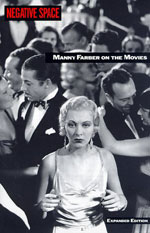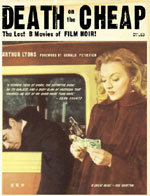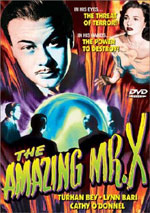Da Capo- play it again | |

|
Da Capo, as in once again, from the top, with feeling. Da Capo, as in the Love album of the same name, Orange Skies burning with righteous anger, as sharp as the guitars on ´Seven and Seven Is'. Black and white, like jasmine leaves in a bowl of rice (thanks Shu).
So it comes as no surprise that some of the best writing on subjects close to my heart are found on the Da Capo Press imprint. Here nestle the works of Manny Farber, some magisterial jazz writing, and colorful accounts of the lives of Al Capone and pianist Hampton Hawes. Manny Farber is a living legend, as unyielding and uncompromising as a slab of granite. I imagine in an earlier age he would have made his living carving out headstones for the dead, like John Fante's father in his great late novels. Truculent and ornery, Farber lives his film writing as a visual adventure, demanding constant attention to the minor details of a scene. Bogart tapping a post after crossing a street, adding that touch of realism to a scene shot on an otherwise artificial Warner Brothers studio backlot in The Big Sleep. Farber replays those moments, excavating layers of forgotten detail, and then puts the pieces back together again. A great iconoclast, he gnaws away at the margins of a work, and doesn't let you go until you've ground out the significance of seemingly ephemeral moments. A true archaeologist of cinema, he takes you back to film as a remembrance of compelling evidence, overlooked initially as insignificant. Da Capo- rewind the tape, goddammit! And watch Bogey tip his hat again. I would love to have sat in at some of Farber's classes when he was teaching film classes. I can imagine him poring over a scene from The Man From Laramie, emphasizing the panoramic compositions Anthony Mann would use, and the zooms into a character's wounded psychology (almost invariably James Stewart's, who is always a demonic figure in Mann's weird western landscapes) through the parallels between oppressive natural boundaries and cramped movement. The archetype of a Western, in other words. Or Farber on avant-garde experiments, such as the work of Michael Snow, surely the only director to have commissioned a full-length Albert Ayler soundtrack (see, or preferably hear, New York Eye and Ear Control). As a visual artist himself, Farber is singularly equipped to make this work seem visually compelling and something which means something to my life, right now. His favoured analogy is that of the termite artist outgunning the elephant artist, and Snow's work burrows its way into your subconscious in the way all great music or films do. On Snow's notorious Wavelength:
|

|
It's a shame the Art Ensemble of Chicago weren't asked to collaborate on any soundtracks after Les
Stances a Sophie. Their work is awash with colours, deep shades of red and green, majestic sienna. In some kind of cosmic afterlife, I'm sure John Arlott would find time to put down his latest Wisden and reach for the princeliest compliments for the Art Ensemble in full flow, on ´Baptizum' or ´Fanfare for the Warriors' for instance. Living firebrands, running rampant with the most simple resources, like Viv Richards carving through the England opening pace attack with nothing but a well-hewn piece of willow and an ivory smile.
Another Da Capo classic is, fittingly, Ekkehard Jost's ´Free Jazz', a wonderful overview of the free blowing scene from Coltrane to Sun Ra. His tone may be rigorously Germanic, and he never flinches from his musicological stance, but it's beneficial to the status of the music to see Cecil Taylor or Don Cherry treated with the same seriousness as a Schoenberg or a Cage. Jost continues the pioneering work of A. B. Spellman in bringing the less well known details of the lives and music to the fore. Spellman's book Four Lives in the Bebop Business was a desert island read for its pages on Herbie Nichols alone, and the destructive criss-cross of influences brought to bear on the magical Blue Note pianist. Jost delivers precise assessments on the shaping influences on the world of trailblazers such as Shepp, Taylor, and Sun Ra. He gives due prominence to the importance of trombonist Roswell Rudd in Shepp's development, which is heartening, and helps avoid categorizing free music as a ghetto for disenfranchised black upstarts. Rudd and Shepp, after all, renewed their collaboration in recent years, and this sparked some of Shepp's best playing in many years, back on track in New York alongside the fiery crackle of Rudd's trombone, heaving and thumping against any young buck daring to cross his path. Jost is a great campaigner for the lesser known items in these players' back catalogues, so it's good to see him promoting Ayler's ´New York Eye and Ear Control' album. Rudd's contribution is, of course, given the most glowing tribute: ´Rudd interposes fragmentary flourishes in the highest register, or growl sounds and glissandos in the manner of the old tailgate trombonists'. It wouldn't be appropriate to write about free music without playing up its primitivistic attributes, but you can't overlook its intellectual complexities either. Along with the barnstorming, there's an alligator's Olympian contemplation of the teeming life-forms above and beneath the surface of its swampy home waters. Sittin' and a rockin', timing its move in for the kill. |

|
If it all sounds like
cloak and dagger at times, music that expresses the law of the jungle, it's an appropriate analogy for Cecil Taylor's giant size footprints. If my hunch is right, only the finest alligator skin goes into making this man's shoes. Taylor turns jazz time into a mythological event, twisting words and images to fit his monumental constructions. Rick Kick Shaw!, he stamps. The guys in Mole Jazz made me smile when I asked about the availability of the Taylor Feel Trio's 10-CD live in London box set - 600 copies still sitting there, ´until a comet hits the earth'. Jost denies Taylor's detractors any sneering dismissal of the pianist's work as rampaging chaos, though, and emphasizes the man's constructionistic approach. He even dwells on Taylor's early Tristano influence, which is a rare thing. I love to think of young Cecil plotting the overthrow of jazz piano as we know it by taking Tristano's
cool lines and releasing their controlled energies as meteor showers of pure
invention. Friendly as a hand grenade. That phrase could apply equally to the pent-up energies and dark forces found in many a black and white B movie. Thankfully, we have No Exit tough guy novelist Arthur Lyons's Death on the Cheap to guide us through the nightmare alleys and dark passages of that genre's addled amnesiac history. Like a poem by Rimbaud, the most potent B movies guide you to a costly illumination. A season in hell as a muddled Parisian thoroughfare, a 10-Franc cinema on either side of you ushering you into a 1940s low-budget revival. Shots of celluloid absinthe knock you back until your vision clouds over and blackout kicks in. Lyons succeeds in locating the noir form in its social context of 1930s Depression and World War a decade later. He justly praises Paul Cain's Fast One as a high watermark of hardboiled writing from the 1930s (reprinted by the great No Exit Press of course), which metamorphoses into a hardboiled visual counterpart in the 1940s with the arrival of Double Indemnity. The noir story is well documented elsewhere, of course, by the likes of James Naremore or in Alain Silver's encyclopedic efforts. The book's real value, though, lies in its alphabetical account of every B studio film noir from 1940 to 1959, the zenith of the noir movement. Or rather, the noir slither, as its lizard-like characters are more likely to slide out from under a rock after midnight than move around in broad daylight. Unsparing in his criticism of clichéd entries in the genre, such as Mike Hammer B feature My Gun is Quick (Lyons concludes: ´I take it back: Everybody dies in this one'), he also reveals an obsessive love of the noir formula, warts and all. Who wouldn't find a compulsive fascination lurking in a tawdry Lionel Atwill picture, given his sordid antics offscreen (documented here and in Hollywood Babylon, which the book echoes at times)? He also unearths some gems which I now have no excuse not to track down, such as The Spiritualist (aka The Amazing Mr. X), photographed by noir specialist John Alton, of Big Combo fame, with its twisted revenant-dead-husband-haunts-widow plot. And he reminds me I haven't seen Ben Hecht's strange trawl through the mysteries of the subconscious, The Spectre of the Rose. Perfect reading then- a mixture of well-worn classics, and ones that got away. A fitting description of Da Capo's work- let's hope they keep their valuable catalogue in circulation, and reprint some lost treasures, like drummer Art Taylor's interview book Notes and Tones. Da Capo, true to its name- take it from the top shelf. © 2003 Marino Guida |